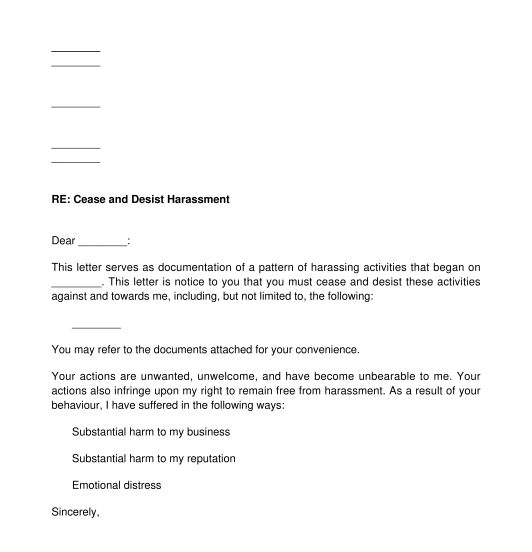 16/10/2025
16/10/2025

Answer a few questions and your document is created automatically.

Your document is ready! You will receive it in Word and PDF formats. You will be able to modify it.

 16/10/2025
16/10/2025
 Word and PDF
Word and PDF
 1 page
1 page
A Cease and Desist is a letter sent to an individual or business that is engaging in unwelcome or illegal behaviour. The Cease and Desist acts as a formal request that the recipient stop ("cease") and not continue ("desist") this behaviour.
If the recipient of the letter fails to comply with these demands, the sender should be prepared to take further legal action to stop the behaviour that is harming or interfering with the sender's rights and abilities to conduct business.
For example, a neighbour is continually going to a neighbour's door complaining about their driving habits in the neighbourhood, uttering threats to slow down, and is following them in public areas to monitor them.
No. Having a Harassment Cease and Desist letter is not mandatory, but it is recommended before initiating court proceedings to showcase the gravity of the situation. A letter is normally always the starting point to any legal action because it puts the person on notice and establishes a record.
A Cease and Desist letter must include the following basic elements:
A Harassment Cease and Desist Letter is but one category of cease and desist letters. These letters can be sent out with respect to other offensive acts being done, such as defamation. If a cease and desist letter relates to anything other than harassment, the general cease and desist letter must be used.
A Harassment Cease and Desist Letter applies to any situation where a person is being harassed, including, for example, a neighbour. However, a Warning Letter of Workplace Harassment applies only in the context of the workplace, such as harassment between colleagues.
Actual harassment must have taken place before this harassment cease and desist letter is sent out. A Cease and Desist letter is specifically tailored to be sent as a demand that an offending party stop the harassing behaviour that is causing physical, mental, emotional, or monetary harm to someone. The letter allows the sender to provide a detailed description of the harassment and specify the ways in which they have been harmed.
This Cease and Desist letter should be used by someone who is being harassed by a coworker, neighbour, or other individual or business. In any other situation, the General Cease and Desist may be used to request a recipient to cease and desist the unwelcome behaviour that does not constitute harassment.
Once the letter has been completed, it may be signed and then sent via registered mail or email to the individual or business that has been conducting the offensive behaviour. Sending the letter by registered mail is recommended as it allows tracking.
After the letter has been sent, it's important to monitor the situation to see if the behaviour has stopped. If not, the sender of the letter may need to consider further legal action, including a lawsuit.
There are no laws outlining what must be included in a Cease and Desist letter. However, best practices dictate that a Cease and Desist include a detailed description of the offending behaviour and a clear demand that the behaviour stop or else legal action will be taken. Further, Cease and Desist letters are often used in later court cases to show that the defendant was put on notice about their offending behaviour, so the more detailed the letter, the better.
It's important to note there's a distinction between liability in criminal law and tort law. Harassment under the Criminal Code is different from civil harassment. In the former, section 264(2) of the Criminal Code outlines harassment as:
Criminal harassment could result in criminal charges and a conviction.
In the latter, the tort of civil harassment has not been specifically recognized in all jurisdictions (see for example Merrifield v Canada (Attorney General), 2019 (ONCA) 205) . The tort of harassment is distinct from sexual or workplace harassment. Where the tort of harassment is not recognized, many plaintiffs file claims under the tort of Intentional Infliction of Mental Suffering. However, where the tort of harassment has been recognized, case law has held that the following elements must be recognized (see for example Alberta Health Services v Johnston, 2023 (ABKB) 209):
You fill out a form. The document is created before your eyes as you respond to the questions.
At the end, you receive it in Word and PDF formats. You can modify it and reuse it.
Harassment Cease and Desist Letter - Sample, template
Country: Canada (English)